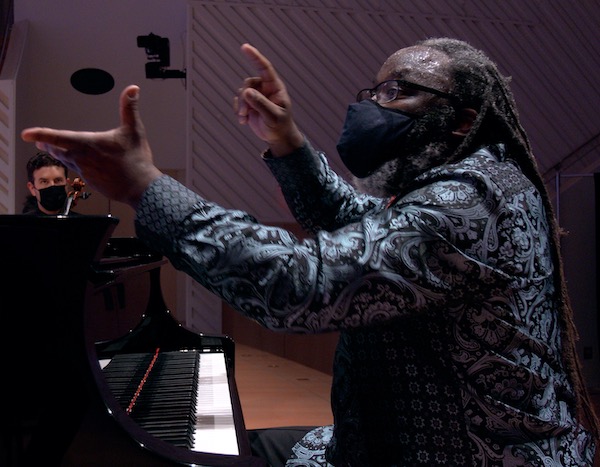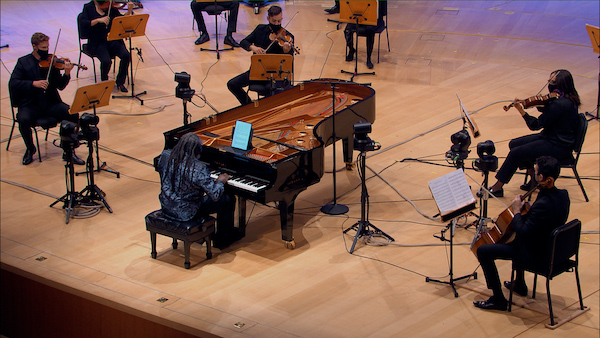Singleton premiere highlights New World’s wide-ranging chamber program

Following two programs that featured an uneven score by Matthias Pincher, a pop-song cycle that hardly belonged on a classical concert and mediocre works by European and American modernists, the New World Symphony returned to form on Sunday afternoon with an engrossing world premiere and diverting mix of new and old fringe repertoire.
Filmed and streamed from the New World Center, the concert spotlighted the first performance of Time Past, Time Present for piano and string orchestra by Alvin Singleton.
Singleton has been a prolific creator of orchestral and chamber works, writing music that defies any single stylistic direction. In a manner reminiscent of Ernest Bloch’s Concerto Grosso No. 1, the piano is less a solo instrument than part of the ensemble in this new score. The 13-minute opus abounds in angular string writing and huge contrasts of volume from barely audible to tumultuous. Thematic invention ranges from darkly sorrowful to neo-Classicism. Singleton manages to constantly surprise as the music never follows expected patterns right down to the abrupt, soft conclusion.

Awadagin Pratt conducted the 20-member string contingent from the piano. (The work was commissioned by Pratt’s Art of the Piano Foundation.) While Singleton’s compelling score mostly did not allow Pratt to display his considerable keyboard virtuosity, he brought subtle coloration to the piano writing and skillfully integrated the distanced strings, drawing fine tonal and dynamic variety.
Tania León’s Saoko for brass quintet was the concert’s outlier. León has written some fine compositions that mix the dance rhythms of her native Cuba with contemporary musical paths—but Saoko is not one of them. In her introductory remarks, she said the title is a term of endearment referring to an uplifting person and that she envisioned a group of street musicians hanging out together. The brief vignette sounds like an improvisation with each of the players going their own way. Morgen Low and Gianluca Farina (trumpets), Scott Leger (horn), Guangwei Fan (trombone) and Andrew Abel (tuba) gave their best efforts to this three-minute cameo but it was likely more fun for them than the listener.
The same group of players were joined by percussionist Matthew Kibert and Thomas Steigerwald on organ for Adolphus Hailstork’s Fanfare on Amazing Grace. As Hailstork noted, this score exists in orchestral, wind band and chamber versions. With the organ playing hints of the famous hymn and brass and percussion sounding joyous proclamations, the work’s four minutes are filled with celebratory spirit. The players gave a brilliant reading of Hailstork’s festive call to rejoice. A stunning video at one point pictured the musicians through stained glass church windows.
Francois Couperin’s Royal Concert No. 2 in D Major was one of 14 suites written for the court of Louis XIV, the “Sun King,” by the French Baroque master. In five short movements, the work can be played by various combinations of instruments. Although often played on the flute, oboist Mark Debski took the lead role in this performance, for the most part successfully. Debski’s lean tone, dexterity and accuracy shone best in the plaintive Air tendre and the graceful flow of the concluding Rondeau. The Air contrefugué could have benefited from more incisive accents with Debski’s phrasing too literal. Cellist Clare Bradford and harpsichordist Wesley Ducote provided outstanding continuo backing. At times Ducote made the early keyboard instrument sound almost like a drum beat.
This streamed pandemic season has afforded the New World’s conducting fellow Chad Goodman opportunities to lead some major scores rather than just overtures to open a concert. Goodman was on the podium for Dvořák’s Wind Serenade in D Major.
Contemporary with his Slavonic Dances, this score finds Dvořák at his most melodically inspired. Eschewing flutes, Dvořák added a cello and bass to the wind players, giving the instrumental texture darker hues. Goodman noted that it was the first work he conducted professionally.
He certainly knows the piece and delivered a delightful performance, replete with charm and emphatic instrumental detailing. There was playful bounce in the furiant section of the second movement and the long melodies of the Andante con moto flowed winningly. The polka of the finale seemed to literally burst off the computer screen at Goodman’s brisk clip. Kelsi Doolittle’s clarinet and Joo Bin Yi’s oboe took special honors in the 12-member ensemble.
Goodman will conduct works by Mozart, Nina Šenk and Joseph Bologne, Chevalier de Saint- George on the New World Symphony’s final program in June.
Michael Tilson Thomas conducts the New World Symphony in William Grant Still’s Patterns, Colin Nancarrow’s Prelude and Blues and Sonatina, Carl Ruggles’ Angels and Charles Ives’ Three Places in New England. Streaming 7:30 p.m. May 8. nws.edu
Posted in Performances
Leave a Comment
Mon Apr 26, 2021
at 12:01 pm
No Comments
